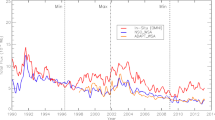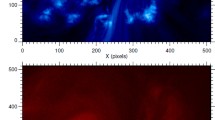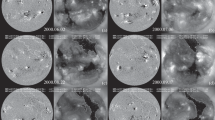Abstract
Coronal holes (CH) emit significantly less at coronal temperatures than quiet-Sun regions (QS), but can hardly be distinguished in most chromospheric and lower transition region lines. A key quantity for the understanding of this phenomenon is the magnetic field. We use data from SOHO/MDI to reconstruct the magnetic field in coronal holes and the quiet Sun with the help of a potential magnetic model. Starting from a regular grid on the solar surface we then trace field lines, which provide the overall geometry of the 3D magnetic field structure. We distinguish between open and closed field lines, with the closed field lines being assumed to represent magnetic loops. We then try to compute some properties of coronal loops. The loops in the coronal holes (CH) are found to be on average flatter than in the QS. High and long closed loops are extremely rare, whereas short and low-lying loops are almost as abundant in coronal holes as in the quiet Sun. When interpreted in the light of loop scaling laws this result suggests an explanation for the relatively strong chromospheric and transition region emission (many low-lying, short loops), but the weak coronal emission (few high and long loops) in coronal holes. In spite of this contrast our calculations also suggest that a significant fraction of the cool emission in CHs comes from the open flux regions. Despite these insights provided by the magnetic field line statistics further work is needed to obtain a definite answer to the question if loop statistics explain the differences between coronal holes and the quiet Sun.
Similar content being viewed by others
References
Altschuler, M. D., Trotter, D. E., and Orrall, F. Q.: 1972, Solar Phys. 26, 354.
Aly, J. J.: 1989, Solar Phys. 120, 19.
Aschwanden, M. J., Nightingale, R. W., and Alexander, D.: 2000, Astrophys. J. 541, 1059.
Belenko, I. A.: 2001, Solar Phys. 199, 23.
Bohlin, J. D. and Sheeley, N. R. Jr.: 1978, Solar Phys. 56, 125.
Brkovic, A., Landi, E., Landini, M., Rüedi, I., and Solanki, S. K.: 2002, Astron. Astrophys. 383, 661.
DeForest, C. E., Hoeksema, J. T., Gurman, J. B., Thompson, B. J., Plunkett, S. P., Howard, R., Harrison, R. C., and Hassler, D. M.: 1997, Solar Phys. 175, 393.
Dowdy, J. F., Jr., Rabin, D., and Moore, R. L.: 1986, Solar Phys. 105, 35.
Feldman, U.: 1998, Astrophys. J. 507, 974.
Feldman, U., Dammasch, I. E., and Wilhelm, K.: 2001, Astrophys. J. 558, 423.
Gabriel, A. H.: 1976, Phil. Trans. R. Soc. Lond. A. 281, 339.
Golub, L., Herant, M., Kalata, K., Lovas, I., Nystrom, G., Pardo, F., Spiller, E., and Wilczynski, J.: 1990, Nature 344, 842.
Harvey, J. W., Krieger, A. S., Timothy, A. F., and Vaiana, G. S.: 1975, Bull. Am. Astron. Soc. 7, 358.
Harvey, K. L. and Recely, F.: 2001, Coronal hole maps prepared at NSO/Kitt Peak by Karen Harvey and Frank Recely as part of an NSF grant. (http://nsokp.nso.edu/dataarch.html).
Harvey, K. L., Sheeley, J. R., and Harvey, J. W.: 1982, Solar Phys. 79, 149.
Kano, R. and Tsuneta, S.: 1995, Astrophys. J. 454, 934.
Kano, R. and Tsuneta, S.: 1996, Publ. Astron. Soc. Japan 48, 535.
Krivova, N. A. and Solanki, S. K.: 2004, Astron. Astrophys. 417, 1125.
Kundu, M. R., White, S. M., Shibasaki, K., and Raulin, J.-P.: 2001, Astrophys. J. Suppl. Ser. 133, 467.
Lagg, A., Woch, J., Krupp, N., and Solanki, S. K.: 2004, Astron. Astrophys. 414, 1109.
Levine, R. H.: 1977, Astrophys. J. 218, 291.
Lin, H., Penn, M. J., and Kuhn, J. R.: 1998, Astrophys. J. 493, 978.
Maxson, C. W. and Vaiana, G. S.: 1977, Astrophys. J. 215, 991.
Marsch, E., Fleck, B., and Schwenn, R.: 2001, in Klaus Scherer, Horst Fichtner, Hans Jörg Fahr, and Eckart Marsch COSPAR Colloquia Series (eds)., The Outer Heliosphere: The Next Frontiers, 11, Pergamon Press, Amsterdam, p. 445.
Marsch, E. E. et al.: 2002, Adv. Space Res. 29, 2027.
Raouafi, N.-E., Sahal-Bréchot, S., and Lemaire, P.: 2002, Astron. Astrophys. 396, 1019.
Rosner, R., Tucker, W. H., and Vaiana, G. S.:1978, Astrophys. J. 220, 643.
Scherrer, P. H., Bogart, R. S., Bush, R. I., Hoeksema, J. T., Kosovichev, A. G., Schou, J., Rosenberg, W., Springer, L., Tarbell, T. D., Title, A., Wolfson, C. J., Zayer, I., and MDI Engineering Team: 1995, Solar Phys. 162, 129.
Schmidt, H. U.: 1964, in W. N. Ness (ed)., ASS-NASA Symposium on the Physics of Solar Flares, NASA SP-50, p. 107.
Semel, M.: 1967, Ann. Astrophys. 30, 513.
Serio, S., Peres, G., Vaiana, G. S., Golub, L., and Rosner, R.:1981, Astrophys. J. 243, 288.
Solanki, S. K., Lagg, A., Woch, J., Krupp, N., and Collados, M.: 2003, Nature 425, 692.
Stucki, K., Solanki, S. K., Schühle, U., Rüedi, I., Wilhelm, K., Stenflo, J. O., Brkovic, A., and Huber, M. C. E.: 2000, Astron. Astrophys. 363, 1145.
Stucki, K., Solanki, S. K., Pike, C. D.; Schühle, U., Rüedi, I., Pauluhn, A., and Brkovic, A.: 2002, Astron. Astrophys. 381, 653.
Waldmeier, M.: 1957, Die Sonnenkorona (II). Birkhäuser Verlag Basel und Stuttgart.
Waldmeier, M.: 1975, Solar Phys. 40, 351.
White, S. M.: 2002, Astron. Nachr. 323, 265.
Wilhelm, K.: 2000, Astron. Astrophys. 360, 351.
Wilhelm, K., Dammasch, I. E., Marsch, E., and Hassler, D. M.: 2000, Astron. Astrophys. 353, 749.
Winebarger, A. R., Warren, H., van Ballegooijen, A., DeLuca, E. E., and Golub L. 2002, Astrophys. J. 567, L89.
Xia, L.: 2003, Equatorial Coronal Holes and Their Relation to the High-Speed Solar Wind Streams. PhD. Thesis Göttingen.
Zhang, J., Woch, J., Solanki, S. K., and von Steiger, R.: 2002, Geophys. Res. Let. 29, pp. 77–1, CiteID 1236, DOI 10.1029/2001GL014471.
Zhang, J., Woch, J., Solanki, S. K., von Steiger, R., and Forsyth, R.: 2003,J. Geophys. Res. 108, pp. SSH 1-1, CiteID 1144, DOI 10.1029/2002JA009538.
Author information
Authors and Affiliations
Corresponding author
Rights and permissions
About this article
Cite this article
Wiegelmann, T., Solanki, S.K. Similarities and Differences between Coronal Holes and the Quiet Sun: Are Loop Statistics the Key?. Sol Phys 225, 227–247 (2004). https://doi.org/10.1007/s11207-004-3747-2
Received:
Accepted:
Issue Date:
DOI: https://doi.org/10.1007/s11207-004-3747-2




